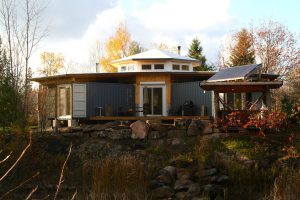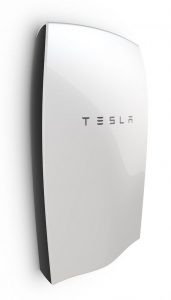By David Dodge & Dylan Thompson
The year 2015 may well go down as the dawning of the age of the super energy-efficient, solar-powered, net-zero home.

Jason Rioux’s shipping container cabin. The cabin was built out of seven sea containers in a hub and spoke pattern near Bobcaygeon, Ontario. This incredibly innovative sea container cabin is powered by a small 1 kW solar system and is packed with energy efficiency innovation – probably part of the reason the video has more than 100k views on YouTube. Photo Courtesy of Jason Rioux
“It’s not a question of if net-zero homes are going to be built — it’s a question of when they’re going to be built,” says Andy Goyda of Owens Corning Canada.
Goyda’s company runs the net-zero ecoEnergy Innovation program on behalf of Natural Resources Canada. The program involves five home builders each constructing five net-zero homes as a learning exercise.
The program requires builders to build their five net-zero homes in succession so the knowledge comes fast and furious on their journey to eventually building affordable net-zero homes for everyone. We visited Reid’s Heritage Homes in Guelph, Ontario and wrote about their first net-zero home and the amazing strides they made between their first and second net-zero builds.
Net-zero 101
Housing is responsible for 15 per cent of Canada’s greenhouse gas emissions. Who wouldn’t get excited about building a home that saves up to half on energy use and produces its own energy for the life of the home?
Net-zero homes burst onto the scene in 2007 with the CMHC Equilibrium program with a dozen pilot net-zero home projects across Canada. Since then dozens of them have been built in Edmonton, Alberta where custom builders are leading net-zero innovation. One builder, Landmark Homes is inching ever closer to the day when all of their new homes are net-zero ready.
The concept has certainly captured the attention of the more than 100,000 people who have viewed our Net-zero 101 video. It seems people are fascinated with the idea of saving money, producing their own energy in their own homes, and protecting themselves from the vagaries of future energy prices.
Net-zero scales up
The year 2015 was the year when net-zero grew up and scaled up. In the past it was common to here that office buildings can’t reach net-zero. “There isn’t enough roof space for solar!” or “ The energy requirements are too high for offices,” are common refrains.
Well, that was then and this was 2015. One of our favourite stories of the year was the opening of the Mosaic Centre, a 30,000 sq. foot solar-powered and geo-exchange heated office building. The Mosaic centre smashes boundaries and did so on budget and ahead of schedule thanks to an innovative partnership between the owner, architects, construction contractors and tradespeople.
“You can throw money at something and make it beautiful and sustainable,” says Christy Benoit who owns the building along with Dennis Cuku of Edmonton, Alberta. “That’s the reality. But for us to be able to inspire others to want to try to go out and do something similar we knew that it needed to make sense financially.”
Green building transformation
People love to knock LEED (Leadership in Energy and Environmental Design) for giving points for things like bike racks, but LEED has helped provide real transformation in the building industry since it’s inception in 2004. Besides, bike racks are a great idea!
More than 5,000 buildings are registered LEED projects and 1,800 buildings have been LEED certified in Canada already. We featured Clark Construction in our story who are diverting up to 95 per cent of construction waste and building increasingly energy efficient buildings out of increasingly greener materials since their first LEED project a decade ago. Today more than 50 per cent of Clark’s projects are LEED candidates and they now use the same materials in all of their projects, whether they are LEED or not.
Cam Munro, Innovative Construction Manager at Clark Builders in Edmonton, Alberta says “LEED has probably done more for the building industry than [the development of] structural steel buildings in the 1860s. LEED has literally made leaps and bounds, because it’s forcing people, engineers, design, builders, owners to think differently.”
Octopod, the off-grid shipping container cabin

When it comes to green energy nothing fits the this changes everything phrase better than Elon Musk announcing the Tesla Powerball in 2015. Indeed the ability to story and shift the use of renewable energy to times of high demand will change everything and make it possible for cities to run on 100% renewable energy. Energy storage will change everything in coming years. Photo courtesy of Tesla
There is no question that a combination of self-reliance, clean energy, and going off-grid fascinates people. Consider the Octopod in Bobcaygeon, Ontario. A one-kilowatt solar system fulfills all the power needs of this off-grid, shipping container cabin.
We’re not sure if it’s the use of sea containers in construction or the super-innovative energy-efficient design of this summer home, but the video for this story has been viewed 94,000 times.
Among the innovations Jason Rioux incorporated into this example of extreme innovation: one-watt LED lights in rooms, a gravity-fed solar-powered water system, DC computer fans to cycle warm air and a super-efficient DC powered freezer. Whether you are simply curious about off-grid living or super energy efficiency, the Octopod is sure to delight.
Switching gears, this year we also travelled to the remote northern town of Boyle Alberta to see one of the biggest waste-to-energy operations anywhere.
The Alberta Pacific Forest Industries (ALPAC) kraft pulp mill uses 450,000 tonnes of wood waste (stuff that can’t be turned into pulp such as bark) each year to feed a boiler. A second 11-storey tall boiler burns spent pulping chemicals, called “black liquor.” Together, these boilers drive two 40-megawatt generators to produce enough electricity to power one of North America’s largest kraft pulp mills.
In 2009 ALPAC also added a 32-megawatt low pressure steam boiler that uses waste steam from the primary boilers together with a 17-megawatt natural gas unit to produce electricity for the grid as a peaking power plant.
Tesla Powerwall fuels the possibilities
There are many who believe energy storage will change everything and nothing brought this home more than Elon Musk’s announcement of the Tesla Powerwall earlier in the year.
This lithium battery energy storage system is elegant, designed for small applications and seemed to fire people’s imagination when it was released. Folks dutifully pre-ordered 38,000 of the energy storage systems when it was announced.
It’s innovation like this that is helping people envision the smart grid of the future where energy storage supports an electricity system that utilizes tons of renewable energy.
Happy New Year to you and may 2016 be a banner green energy year!






